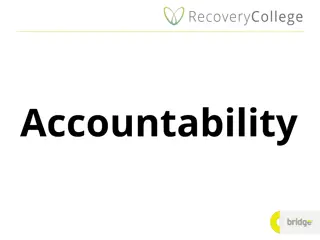Developing SMART Goals for Personal Growth and Success
Explore the importance of setting realistic goals for personal development, studies, and career success. Learn how to turn ambitions and dreams into achievable goals, prioritize them effectively, and implement the SMART goal-setting approach for maximum impact. Discover the qualities of SMART goals and how to ensure they are specific, measurable, achievable, relevant, and time-bound. Empower yourself to track progress, celebrate successes, and navigate setbacks on your journey towards success and fulfillment.
Download Presentation

Please find below an Image/Link to download the presentation.
The content on the website is provided AS IS for your information and personal use only. It may not be sold, licensed, or shared on other websites without obtaining consent from the author. Download presentation by click this link. If you encounter any issues during the download, it is possible that the publisher has removed the file from their server.
E N D
Presentation Transcript
Life Orientation: Life Skills NQF 2 Life Orientation NQF Level 2
Set realistic goals for your personal development, studies & career Module 2 *see terms and conditions
Think about it Why is it important to change my ambitions & dreams into goals? How do I decide which goals are the most important for now? What is the connection between goals & success?
Unit 2.1 Setting & prioritising goals Life Orientation NQF Level 2
What is a goal? Something that you want to achieve in the future. Goals can be: Short-term (within a few weeks/months). Medium-term (within one or two years). Long-term (within three or more years).
What are SMART goals? Specific (clear). Measurable (steps to reach). Achievable (possible). Realistic (relevant to you). Time-bound (by dates). Figure 2.1: SMART gets even smarter! Your goals should be ethical & you should record your progress, successes & any failures or setbacks
What are SMART goals? Table 2.1: Qualities of SMART goals Description Qualities Examples Specific The goal should be clear, precise and detailed: What do you want to accomplish? A broad goal is: I want to become fit. Cebo s specific goal is: I will enter a 10 km road race this year and finish it comfortably. A measurable goal for Cebo is: I will follow a training programme that will take me from a beginner runner to a 10 km contestant in just 25 weeks. Measurable You should be able to measure your progress: What steps must you take to achieve the goal? Which criteria must the goal meet along the way?
What are SMART goals? Table 2.1 (continued): Qualities of SMART goals Description Qualities Examples Achievable The goal should be possible to reach, otherwise you will be disappointed. However, the goal shouldn t be too easy either. The training programme alternates walking with running for the first 16 weeks. Cebo needs to train for half an hour, five days a week. He decides that this is a manageable routine. He will run after classes and study in the evenings.
What are SMART goals? Table 2.1 (continued): Qualities of SMART goals Quality Description Example Realistic The goal should be relevant to your interests, abilities and values. Does the goal have real relevance to who you are? Will it really matter if you achieve this goal? Cebo doesn t like contact sports and prefers the freedom of the outdoors. He also feels no need to be in competition with others and wants to run just for the pleasure of being fit.
What are SMART goals? Table 2.1 (continued): Qualities of SMART goals Quality Description Example Time- bound The goal should be time- based. When do you want to achieve your goal? What are the dates for the different steps leading up to the final date? Cebo has chosen a road race in his area in six months time. This will give him sufficient time to be well prepared for his first 10 km run.
Module 2Learning activity 2.1 Test your knowledge of this section by completing Learning activity 2.1 in your Student s Book. Life Orientation NQF Level 2
How can you prioritise your goals? Decide the importance of each goal. Divide into short-, medium- & long-term goals. Does your goal have long-lasting benefits? Which goal energises you the most?
Learning activity 2.2 Module 2 Test your knowledge of this section and your own goals by completing Learning activity 2.2 in your Student s Book. Life Orientation NQF Level 2
Unit 2.2 Perseverance Life Orientation NQF Level 2
What is perseverance? Carrying on with a task until it is completed. Not being distracted, discouraged or giving up. Showing determination, dedication, strength & patience.
Examples of perseverance Refer to Case studies 2.1 and 2.2 in your Student s Book. Think about other examples of perseverance. How do you finish a race? One stride at a time. How do you acquire a skill? One practice session at a time. How do you get fit? One exercise after another. The secret is to start, and then to persevere.
Module 2Learning activity 2.3 Test your knowledge of this unit by completing Learning activity 2.3 in your Student s Book. Life Orientation NQF Level 2
Unit 2.3 Factors that impact positively on the achievement of goals Life Orientation NQF Level 2
Qualities we choose for ourselves Table 2.2: Qualities we choose for ourselves Qualities Attitudes Description This is how you choose to think, feel and behave. Your attitude makes you respond either positively or negatively to circumstances, ideas and other people. These are the principles or standards that you hold as important and that guide your decisions and actions. At a deeper level, your values reflect what you think is morally right or wrong. These are the ability to do something very well. Such expertise is developed through gaining knowledge, training and practice. Values Skills
Positive factors affecting your goals Figure 2.12: A diagram showing some of the attitudes, values & skills that have a positive impact on our goals
Learning activity 2.4 Module 2 Test your knowledge of this unit and think about how positive influences help you by completing Learning activity 2.4 in your Student s Book. Life Orientation NQF Level 2
Unit 2.4 Factors that impact negatively on the achievement of goals Life Orientation NQF Level 2
Negative factors affecting your goals Peer pressure. Making harmful choices. Self-sabotage. Lack of perseverance. Absenteeism. Late-coming. Laziness. Unplanned pregnancy. Poverty. Taking care of minors.
How can you deal with negative factors? Table 2.5: Examples of ways to deal with negative factors affecting the achievement of goals Negative influences Examples of ways to overcome these obstacles Absenteeism Resist the temptation to skip classes or training sessions, as it will set you back in terms of understanding and practice. Arrange to meet a fellow student before each class, so that you can inspire each other to attend. Late-coming Use an alarm or reminders on your phone or computer, or a digital alarm clock. Ask a friend to call or text you an hour before an appointment so that you can organise yourself to be on time. Laziness Plan your day the previous evening, get up early the next day and keep a positive attitude. The more you keep moving, the more you will be energised in body and mind.
How can you deal with negative factors? Table 2.5: Examples of ways to deal with negative factors affecting the achievement of goals Negative influences Examples of ways to overcome these obstacles Unplanned pregnancy Plan pregnancies around your goals as a couple and as individuals. Take measures to prevent unplanned pregnancies. Poverty Don t allow your mind and heart to be defeated by your circumstances. Use opportunities to sharpen your talents and skills. You will reach your goals if you are diligent, honest and trustworthy, and keep a positive attitude. Taking care of minors family members or children. Find out about organisations in your community that can help you. Think ahead about family planning and discuss the timing of pregnancies with your partner. Call on neighbours, friends and family to assist you with daily tasks in looking after younger
How can you deal with negative factors? Table 2.5: Examples of ways to deal with negative factors affecting the achievement of goals Negative influences Examples of ways to overcome these obstacles Peer pressure Try to spend time with people who have the same interests or goals as you. Encourage one another in reaching each step. Avoid people who mock you, or tempt you to go along with things that you know are harmful. Making harmful choices that you know isn t good for you. Use the small choices in your everyday life to practise making the right choices. This will develop your self-discipline. Self-sabotage Think thoughts and say things that affirm your self-esteem and strengthen your determination and courage to reach your goal. Write down your list of affirmations and read them out loud to yourself every day. Stay away from situations where you may be tempted or pressurised into making a choice
How can you deal with negative factors? Table 2.5: Examples of ways to deal with negative factors affecting the achievement of goals Negative influences Examples of ways to overcome these obstacles Lack of perseverance example, complete homework assignments and housework before you reward yourself with something nice. Recommit yourself daily to achieving your goals. Practise persevering and sticking to your decisions and schedules in all situations. For
Module 2Learning activity 2.5 Test your knowledge of this unit and factors that have prevented you from reaching your goals by completing Learning activity 2.5 in your Student s Book. Life Orientation NQF Level 2
Summative assessment Module 2 Test your knowledge of this module by completing the Summative assessment of Module 2 in your Student s Book. Life Orientation NQF Level 2
Mathematics NQF Level 2 Life Orientation (Life Skills) NQF Level 2

















































